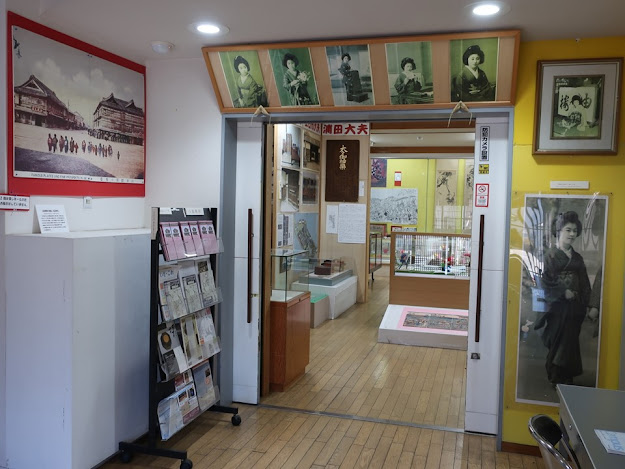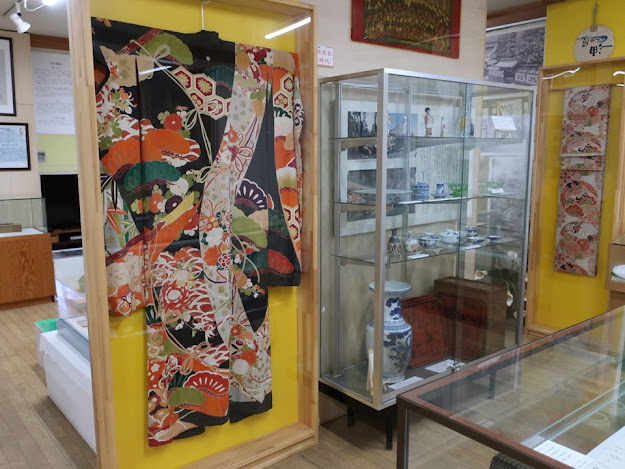“I'm eager to visit Ise, even just for once in my life.” is a lyrics from “Ise dance song”. Going to Ise Shrine was a people’s dream in the Edo period (1603~1868). --- Furuichi Sangu-kaido (highway) flourished with
Ise tour. Especially, Furuich town was the one of three largest red-light-districts along with two others which were Yoshiwara in Tokyo and Shimabara in Kyoto. There
were one thousand fancy ladies and seventy houses “Girou” for them in its prime time.
---
"If you are at Furuich, you can imagine the voices of excited pilgrims who finally arrived at Ise. You can also imagine the voices of travelers who were satisfied in achieving their goals of the pilgrimage, and started walking to their home towns. They had many stories about Ise which they would talk about to their friends in their villages.”
Those are written on the panel near the
entrance of this museum. I totally agree! I could imagine how people enjoyed
travelling here. Furuich kaidou links Geku and Naiku of Ise Shrine.
入口近くのパネルから引用します。
「『伊勢にいきたい伊勢路がみたい、せめて一生に一度でも』と道中伊勢音頭にうたわれたように、江戸時代の伊勢参りは庶民の夢であった。(中略)
外宮から内宮に向かう古市街道は、伊勢参りと共に栄えました。その中でも古市は、江戸の吉原・京の島原と並ぶ三大遊郭があり、その全盛期には妓楼七十軒・遊女千人を数えました。(中略)
耳を澄ませば、聖地を目前にし心弾ませる人、無事念願を果たし、土産話を心に遠い故郷に心馳せる人の喧噪が聞こえてきそうな古市街道。これらの文化遺産は、往時の古市の姿を語っているようです。」
その通り。往時、人々が楽しんだ様子が伝わってきます。古市街道は、伊勢に来たらはじめに、お参りする外宮と、天照大御神が鎮座する内宮を結ぶ街道です。

Geisha girl photos are shown at the entrance. The exhibition room is behind it.
エントランスには、芸者さんの写真が貼ってあり、その奥に展示室があります。
Inns、古市の旅館

The photo above is “Asakichi” inn which described in the popular novel (Toukaidouchu hiza kurige) which was written in the Edo period. The amazing thing is that we can stay here even until now.
いきなり妓楼の紹介も何なので、まずは、旅館の紹介から。上は東海道中膝栗毛にも名前が出ているという麻吉です。営業を続けているのが素晴らしい。(http://iseyado.com/oyadolist/asakichi/)

“Daiyasu” inn exuded a certain dignity.
旅館の大安。風格があります。

Large party room: many people would have enjoyed here.
立派な大広間。たくさんの人が楽しんだのでしょうねえ。

The signboard and large plates of Daiyasu inn.
大安の大皿と提灯、瓦。何れも立派です。

The last one is “Yaduya” inn which was run until the early 20th century.
最後は、江戸時代末から昭和初期まで営業した旅館、矢津屋さん。
Girou (fancy girl house)、古市の遊郭

Sugimotoya: one of three great Girous in Furuich. A big party is held on the second floor.
古市三大妓楼の一、杉本屋。二階で大宴会です。

Sugimotoya had an inn, too. However, it was burned down in 1939.
杉本屋は旅館を併設した妓楼でしたが、昭和14年に焼失してしまいました。

Tray storages: the chrysanthemum was the crest of Sugimotoya, but no one could use it except for the royal family since 1869.
杉本屋のお膳の箱:菊紋が特徴でしたが、明治2年、皇室以外の使用が禁止されました。

Bizenya: visitors enjoy Ise Ondo dancing.
次は、備前屋。伊勢音頭で宴会です。

Postcards of Bizenya、備前屋の絵はがき

Aburaya、続いて、油屋さん


Photos of Geish girls and so on around 1930s.
芸者等の写真(昭和初期~昭和10年)とあります。

People are reveling, the man and the lady in center seem to compete how much they can drink. I like this photo.
謎の馬鹿騒ぎが気に入りました。芸者さんと飲み比べ? ちょんまげ頭で絶好調です。

This is an invitation letter from a prostitute to her customer in the end of the Edo period. I saw the prostitute’s letter for the first time,
お客の来訪を促す、江戸末期の手紙。遊女の手紙は初めて見ました。

忌竹さんから茂三郎さんへのお誘いの手紙です。艶文と言うらしいです。訳文付き。

These are wrapping papers for gifts (towels) from ladies in Sugimotya. Thanks for preserving these until now.
杉本屋さんの女性が、お披露目の挨拶で配ったタオルの熨斗(のし)。残している人がいるのですねえ。
Contract form of employment of a prostitute: it was written “the lady borrowed money from employer and …”. It’s graphic.
娼妓稼人の契約証書のひな形。第二条には、「娼妓は貸座敷営業者より金を借用し」とあり生々しいなあ。
The growth and decay of this district is shown on this panel. The information is rich enough to write an article.
遊郭の盛衰が写真と共にコンパクトに纏められています。このポスターだけで記事を一つ書けるほど、情報がいっぱい。
Boy’s trip to Ise、少年の伊勢への旅
Sons of wealthy families made a pilgrimage to Ise and stayed at Daiyasu inn. Their parents sent a letter to Daiyasu, “After visiting Ise Shrine, let my son be entertained at large girous in Furuichi.”
After dinner, a head clerk escorted him to the girou and told that it was a first experience for him. Prostitutes entertained him with various plays including board games.
Next morning, he returned to Daiyasu, and an envelope with the crest of the girou arrived thereafter. Her letter and hand towel were in it which were best souvenirs to his parents. It was a kind of passage rites.
Reference: Photos of lives (5) gathering (Sudou et al., 1989)
京都や滋賀の良家の子息は19歳になると伊勢参りをします。宿は大安で、親から宿に、「ご参拝が済みましたら、必ず古市の大店で遊ばして下さい」と手紙が届きます。
夕食がすむと宿の番頭が、備前屋や杉本屋に案内し、「初めての遊びの方だから」と念を押します。女郎は、将棋や碁もできて、男に合わせた遊びで楽しませてくれます。
朝になって、大安に帰ってくると、追って、定紋付の封筒が届きます。中には、女郎からの手紙と名入りの手拭いが入っていて、親への何よりの土産になったそうです。通過儀礼ですね。
引用:写真でみる日本生活図引き/5つどう(須藤功編、1989)
Ise Kabuki play、伊勢歌舞伎

A stabbing incident happened at Aburaya in 1796, and it became a Kabuki act. Ise flourished as a Kabuki performance place, too.
1796年に油屋で起きた酒席での殺傷事件は歌舞伎の演目になりました。伊勢は歌舞伎の興行地としても栄えました。
Costume of Ise Kabuki in the early 20th century
大正時代の歌舞伎の衣装と酒器や茶碗
Pilgrimage to Ise、伊勢参り

The picture above depicts travelers to Ise in 1830. It is said five million people surged that year. It was the best entertainment at that time. They had ladles.
文政13年(1830)の伊勢参り。500万人が訪れたといいます。庶民の一番の楽しみでした。よく見ると、皆さんひしゃくを持っています。笠には居住地が書かれていますよ。

A ladle in 1830: if people showed this, they could pass the checkpoint. Moreover, residents supplied meals and water to them.
文政13年(1830)のひしゃく。これを見せると関所を通過できるだけでなく、飯や水を施してもらえたそうです。

Ferry of Miyagawa river (1855, by Hiroshige): various people rushed to the ferry to go to Ise Shrine. Some are in the river.
伊勢参宮宮川の渡し(1855年、広重画)。いろいろな人が押しよせています。

Street musicians had played at Ainoyama in Ise since 1660s. They played shamisen guitars or Chinese fiddles in a shed. “Osugi and Otama”(upper right), who were female performers became popular, played until the late 19th century.
間の山(あいのやま、現伊勢市尾上町)に、1660年頃からストリート・ミュージシャンが出てきました。小屋掛けをして三味線や胡弓にのせて歌います。やがて、女性大道芸人「お杉お玉」(右上)ともてはやされて人気になり、明治時代も活躍したそうです。

Souvenirs: it is written that the origin of a souvenir (miya-ge in Japanese) was the box which was given by the shrine (miya). People bought these for villagers of their home towns. Mankintan (panacea) was a typical souvenir. The signboard of Mankintan is exhibited (right).
伊勢のおみやげ。伊勢せきやさんのパンフレットには、お宮さんで頂戴した箱を「みやげ(宮笥)」と言い、餞別をいただいた人たちに買って帰ったのが、お土産の始まりだと書いてありました。トリビアだ。万能薬の萬金丹もお土産の一つです。
Onshi、伊勢の御師

Onshi was a staff of Ise Shrine, however, they were also tourist agents to invite worshippers to Ise. Moreover, they run inns.
Reference: Onshi, Sndachi, Syukubo
伊勢神宮のみ「おんし」と読みます。御師は、下級の神職ですが、伊勢に参拝客を呼び込む旅行代理店兼旅館の仕事をしていました。

This board was offered by the Kou in Gunma when they offered the Kagura dancing by shrine performers to Ise Shrine in 1869. But the Onshi system was abolished by the government soon after in order to modernize shrines. By the way, we can offer a dancing even now if you donate more than fifty thousand yen.
Reference (Photos and video of Kagura dancing、伊勢のお神楽):
https://www.isejingu.or.jp/visit/prayer/kagura.html
群馬県前橋市の講が、明治二年に太々神楽を奉納した時に奉納した額です。その二年後には、太政官布達(神宮改革)によって御師は廃止になってしまいました。ちなみに、今の太々神楽の奉納の初穂料は、5万円からです。


Tableware of Urata-dayu (Onshi) treated many pilgrims.
御師・浦田太夫の調度品。多くの参拝客をもてなしました。

This is the sole former Onshi house in Ise City, Maruoka-dayu house. It had believers from eight thousand houses in Osaka, Nagano and so on, but it was still a mid-size Onshi.
伊勢市内に唯一現存する御師邸の丸岡宗太夫家。大阪や長野に八千軒ほどの檀家を持つ中規模の御師だそうです。
Ofda talismans (left and center) and Ise calendar which was useful for agriculture. Some Onshi delivered these to their customers across Japan.
御師が配ったお札や農作業に役立つ伊勢暦。左端が丸岡家のお札です。これらをお土産として全国を行脚することもあったそうです。

Oharai-bako (box): Onshi gathered old talismans and kept them in this box. “Oharai-bako” means “to throw away something or to fire someone” at present. I found the reason here.
御祓箱(おはらいばこ)。伊勢の御師は、古いお札をこの箱に入れたといいます。おはらいばこの語源だそうです。これもトリビア。

An actress Kiki Kirin (1943-2018) left her picture and autograph on the notebook in 2013. She had a good sense of writing and drawing.
樹木希林さんのサインも展示されていました。ノートに書いたものですが、味がありますねえ。亡くなる六年前のものです。
Furuich kaidou and Ise Shrine、古市街道と伊勢神宮

The traffic is not so much now, but it keeps the atmosphere of a kaidou road.
古市街道は今は交通量が少ないですが、雰囲気が残っています。

Geku shrine (Magatama pond and stage for offering performances)
外宮(勾玉池と奉納舞台)


Uji bridge is the entrance of Naiku shrine. The end of the bridge is a sacred area.
内宮の入口、宇治橋。この先は神域です。

Main hall of Naiku、内宮正宮
Reference:Ise shrine 伊勢神宮

Okage street in front of Naiku. There are many shops and restaurants.
門前のおかげ横丁
Seven funs(楽fun)were found. Visited in March, 2020
Official website: http://www.amigo.ne.jp/~furuichi/(in
Japanese), accessed in September, 2020
Previous post (Museums on Toukaidou high-way in the same prefecture):
Museums in Seki post town (part2)
東海道 関宿の資料館 (2)
Next post (Museum
on Toukaidou high-way in the same region):





Comments
Post a Comment